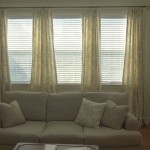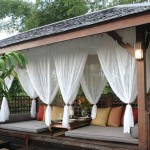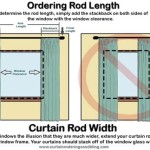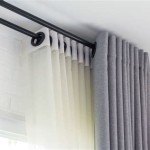Light and Sound Blocking Curtains: Enhancing Comfort and Improving Environment
Light and sound blocking curtains are specialized window treatments designed to minimize the transmission of light and noise into a room. These curtains serve both functional and aesthetic purposes, offering benefits ranging from improved sleep quality to enhanced energy efficiency and increased privacy. Understanding their construction, effectiveness, and suitable applications is crucial for making informed decisions when considering these window coverings.
The primary function of light blocking curtains, often referred to as blackout curtains, is to impede the passage of external light. This feature is particularly beneficial in bedrooms, home theaters, and nurseries, where darkness is conducive to restful sleep, immersive entertainment, and undisturbed rest for infants. Sound blocking curtains, on the other hand, aim to reduce the amount of external noise entering a space, creating a quieter and more peaceful environment. This is highly advantageous in urban settings, apartments near busy streets, or any location where noise pollution is a concern.
The effectiveness of light and sound blocking curtains is determined by several factors, including the fabric composition, weave density, and the presence of additional layers or coatings. The specific needs of a given space should be assessed before selecting curtains to ensure optimal performance. Considerations such as the level of light and noise pollution, the size and orientation of the windows, and the desired aesthetic should all influence the final choice.
Fabric Composition and Density
The materials used in the construction of light and sound blocking curtains significantly impact their performance. Dense, tightly woven fabrics are generally more effective at blocking light and absorbing sound than lighter, loosely woven materials. Common fabrics used in these curtains include polyester, microfiber, and heavy cotton blends. These materials offer a balance of durability, affordability, and light/sound blocking capabilities.
Polyester is a widely used synthetic fabric known for its durability, wrinkle resistance, and affordability. Its inherent density provides a decent level of light blocking, and it can be enhanced with coatings or linings to improve its performance. Microfiber is another popular option, offering a soft texture and good light blocking properties. It is often used in combination with other materials to create multi-layered curtains.
Heavy cotton blends, such as canvas or duck cloth, are natural options that provide a substantial barrier against light and sound. These fabrics are durable and offer a more traditional aesthetic. However, they may be more prone to shrinkage and wrinkles compared to synthetic materials. The weight and thickness of these fabrics contribute to their sound dampening capabilities.
Beyond the base fabric, some curtains incorporate specialized materials to enhance their performance. These include blackout linings made of opaque rubber or vinyl, and sound-absorbing layers composed of dense, felt-like materials. These additions significantly improve the light and sound blocking capabilities of the curtains, making them suitable for environments where maximum performance is required.
Construction Techniques and Layering
The way in which light and sound blocking curtains are constructed plays a crucial role in their effectiveness. Multi-layered curtains are generally more effective than single-layer options, as each layer contributes to blocking light and absorbing sound waves. The layers can consist of different materials, each designed for a specific purpose.
A typical multi-layered curtain might consist of a decorative outer layer, a blackout lining, and a sound-absorbing inner layer. The outer layer provides the desired aesthetic, while the blackout lining blocks light and the sound-absorbing layer dampens noise. The combination of these layers creates a comprehensive barrier against both light and sound.
Seams and stitching can also impact the performance of light and sound blocking curtains. Gaps or poorly stitched seams can allow light to leak through, reducing the effectiveness of the blackout feature. Similarly, loosely stitched seams can allow sound to pass through. High-quality curtains will have tightly stitched seams and reinforced edges to minimize these issues.
The type of heading or hanging style also influences the performance of the curtains. Grommet tops, for example, can create small gaps at the top of the curtain, allowing light to enter. Tab tops and rod pockets may offer better light blocking, as they provide a more closed fit against the curtain rod. However, the effectiveness of these styles depends on the tightness of the fit and the presence of a valance or other covering to block light from above.
Installation and Additional Considerations
Proper installation is essential for maximizing the effectiveness of light and sound blocking curtains. The curtains should be installed as close to the window frame as possible to minimize light gaps. Overlapping the curtains on either side of the window and extending them beyond the top and bottom of the window frame can further reduce light leakage.
Using wrap-around curtain rods can also help to minimize light gaps. These rods curve back towards the wall, preventing light from entering from the sides of the curtains. This is particularly effective in bedrooms or other spaces where complete darkness is desired. Furthermore, installing a valance or cornice above the curtains can prevent light from entering from the top of the window.
In addition to the curtains themselves, other factors can influence the overall light and sound environment of a room. The type of window, the thickness of the walls, and the presence of other sound-absorbing materials can all impact the perceived noise levels. In some cases, addressing these other factors may be necessary to achieve the desired level of comfort and privacy.
Regular maintenance is also important for preserving the performance and appearance of light and sound blocking curtains. Dusting or vacuuming the curtains regularly can prevent the buildup of dirt and debris, which can reduce their effectiveness. Following the manufacturer's instructions for cleaning and care is essential to avoid damaging the fabric or coatings.
Ultimately, the choice of light and sound blocking curtains depends on the specific needs and preferences of the individual. By considering the fabric composition, construction techniques, installation methods, and other relevant factors, it is possible to select curtains that provide optimal performance and create a more comfortable and peaceful living environment. Careful consideration and informed decision-making are key to realizing the full benefits of these versatile window treatments.
The effectiveness of light and sound blocking curtains also extends to energy conservation. By blocking sunlight during the hottest parts of the day, these curtains can help to reduce the amount of heat entering a room, thereby lowering cooling costs. Similarly, by trapping heat during the winter months, they can help to reduce heating costs. This energy-saving feature makes light and sound blocking curtains a cost-effective investment in the long run.
In addition to the practical benefits, light and sound blocking curtains can also enhance the aesthetic appeal of a room. They are available in a wide range of colors, patterns, and styles to complement any décor. Whether the goal is to create a cozy and inviting bedroom, a sophisticated and professional home office, or a comfortable and immersive home theater, there are light and sound blocking curtains to suit every taste. The versatility of these window treatments makes them a valuable addition to any home or office.
The market offers a wide variety of light and sound blocking curtains, ranging from budget-friendly options to high-end, custom-made designs. The price of the curtains can vary depending on the fabric, construction, features, and brand. Comparing different options and reading reviews can help consumers make informed decisions and find the best curtains for their needs and budget.

Acoustic Curtains Sound Reducing Drapes

Acoustic And Sound Absorbing Curtains Georgia Stage

2 Panels Of Light Blue Blackout Curtains Thick Linen Textured Design Heat Sound Blocking Noise Reduction Privacy Protection For Living Room Bedroom Kitchen Office Hotel Home Decor Easy

Deconovo Denim Blue Total Blackout Curtains 45 Inch Length Faux Linen Full Light Blocking Thermal Insulated Soundproof For Boys

Sound Proof Acoustic Curtains Heavy Weight Blackout Custom Stop Drafts Certified To 2db With Windows 10db As Room Divider Etsy

Blackout Curtains Noise Reducing Full Light Blocking Soundproof 100 X84

Tested The Best Soundproof Curtains For A Tranquil Oasis Bob Vila

Dwcn Short Blackout Curtains For Kitchen And Bedroom 2 Panels Sound Proof Thermal Insulated Light Blocking Window Curtain With Black Liners Navy Blue 52 W X 45 L Wal Com

Did You Hear The One About Soundproof Curtains Stella And Blinds

Research Led To Transpa And Light Sound Absorbing Curtains Robaid
See Also








